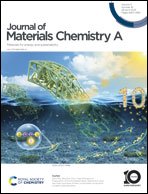CO2 reduction on the Li–Ga liquid metal surface†
Abstract
Reducing CO2 emissions is crucial for the future survival of the planet and the demand for innovative technologies to capture and reduce CO2, focusing on global net-zero carbon emissions is growing significantly. Hence, researchers worldwide are investigating approaches to mitigate the greenhouse effect caused by excessive emissions of CO2. Low melting point liquid metals offer promising opportunities to exploit novel chemistry in negative emission technologies. In this paper, a high-yield, safe and on-demand approach based on Li-containing liquid metal for the reduction of CO2 to solid materials at low temperatures and atmospheric pressure is reported. In this process, Li metal plays a major role in driving the dissociation of CO2 to its elemental constituents, carbon and oxygen. During the CO2 reduction process, Li dissolved in gallium liquid metal, diffuses to the liquid–gas interface and reduces CO2 to carbon, while undergoing an oxidation reaction. The resulting crust that forms on the surface of the Li–Ga liquid metal alloy consists of solid carbonaceous materials that can be directly utilized as a supercapacitor, achieving a sustainable process for CO2 reduction. The use of Li–Ga liquid metal alloys enables CO2 conversion at near room temperature producing carbonaceous materials that can be effectively integrated into energy storage systems.



 Please wait while we load your content...
Please wait while we load your content...